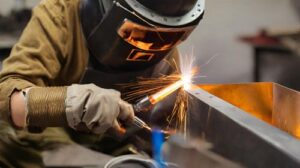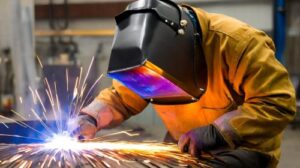Table of Contents
- 1. What Defines a Snakebelly Welding Lens?
- 2. Benefits of Using Snakebelly Welding Lenses
- 3. Types of Snakebelly Lenses
- 4. Factors for Choosing
- 5. Tips for Proper Maintenance and Care
- 6. Application and Industry Use Cases
- 7. Future Developments and Innovations
- 8. Pros and Cons
- Conclusion
- FAQs:
- Are snakebelly welding lenses compatible with all welding techniques?
- How often should I clean my snakebelly welding lens?
- Can snakebelly lenses be customized based on individual preferences?
- Do snakebelly lenses reduce eye fatigue during prolonged welding sessions?
- What advancements can we expect in snakebelly lens technology in the coming years?
Welding is a craft that demands precision, skill, and, most importantly, safety measures to ensure the protection of welders’ eyesight. The evolution of welding technology has introduced various lenses, each designed to enhance visibility and safeguard the welder’s eyes. Among these innovations, the snakebelly welding lens stands out as a pinnacle of advancement in this field.
Let’s embark on an exploration of this revolutionary technology and uncover its myriad facets.
1. What Defines a Snakebelly Welding Lens?
Snakebelly welding lenses are characterized by their unique design, featuring a specialized curvature and tint distinguishing them from conventional welding lenses. Unlike their traditional counterparts, snakebelly lenses offer unparalleled clarity and protection, revolutionizing the welding experience.
2. Benefits of Using Snakebelly Welding Lenses
The utilization of snakebelly lenses brings forth a myriad of advantages. Firstly, they significantly enhance visibility during welding tasks, reducing eye strain and providing a clear view of the workpiece. This heightened clarity translates to improved precision and accuracy, which is crucial in achieving high-quality welds. Moreover, these lenses prioritize the safety of welders, shielding their eyes from harmful UV rays and intense light emissions, ensuring long-term eye health.
3. Types of Snakebelly Lenses
Snakebelly lenses come in various types, each tailored to meet specific welding requirements and environmental conditions. Understanding these variations is crucial for welders to choose the most suitable lens.
Coating Technologies
-
Anti-Glare Coating
An anti-glare coating is a common feature in snakebelly lenses, significantly reducing glare caused by intense welding arcs. This coating ensures welders have a clear view of their workpiece without being blinded by excessive light.
-
Anti-Fog Coating
Welding environments often experience fluctuations in temperature, leading to lens fogging. Snakebelly lenses with anti-fog coatings prevent fog accumulation, ensuring continuous visibility and uninterrupted workflow.
-
Scratch-Resistant Coating
Welding involves abrasive materials and debris that can easily scratch lenses. Snakebelly lenses with scratch-resistant coatings maintain optical clarity by resisting scratches, enhancing durability, and prolonging the lens’s lifespan.
-
UV and IR Protection
The core function of snakebelly lenses is to protect against harmful ultraviolet (UV) and infrared (IR) radiation emitted during welding processes. These lenses feature specialized filters that effectively block these damaging rays, preserving the welder’s vision and eye health.
Adaptability to Light Conditions
Some snakebelly lenses come with adaptive technology, adjusting their tint or darkness based on the intensity of the welding arc. This adaptability ensures optimal vision across varying light conditions, offering consistent clarity without compromising protection.
Specialized Environments
Certain snakebelly lenses are designed for specific welding environments. For instance, lenses optimized for outdoor welding might incorporate features to combat excessive sunlight, while those for confined spaces might prioritize anti-fog and anti-glare properties.
Understanding the diverse coatings and functionalities available in snakebelly lenses empowers welders to make informed decisions based on their working conditions. The versatility of these lenses ensures that welders can find the right fit for their unique welding requirements.
4. Factors for Choosing
Selecting the right snakebelly welding lens involves considering several key factors influencing performance, durability, and suitability for different welding tasks.
Durability and Longevity
Material Quality
The material composition of a lens significantly affects its durability. High-quality lenses often feature robust materials that withstand impacts, scratches, and extreme conditions commonly encountered in welding environments.
Coating Resilience
The durability of coatings, such as anti-glare, anti-fog, and scratch-resistant layers, is crucial. Lenses with resilient coatings maintain their effectiveness over prolonged use, ensuring long-lasting clarity and protection.
Optical Clarity
Distortion-Free Vision
Optical clarity is a cornerstone of snakebelly lenses. A lens that offers distortion-free vision ensures welders have an accurate view of their work, enhancing precision in welding tasks.
Glare Reduction
The ability of a lens to minimize glare is essential for uninterrupted visibility. Welders benefit from reduced eye strain and improved focus when glare is effectively managed.
Compatibility and Adaptability
Helmet Compatibility
Ensuring compatibility with various welding helmets is crucial. Some lenses may have specific design requirements or sizes that may not fit all helmet models, necessitating careful consideration during selection.
Versatility in Environments
Welders often work across diverse environments. A lens that adapts to different lighting conditions, such as outdoor or indoor settings, enhances its usability across various work scenarios.
User Experience and Reviews
Feedback from Welders
User experiences and reviews provide valuable insights into a lens’s real-world performance. Considering feedback from fellow welders aids in making informed decisions and understanding the practical aspects of using specific lenses.
Brand Reputation
Well-established brands with a reputation for quality and innovation in welding technology often offer reliable lenses. Researching and choosing reputable brands can significantly impact the overall satisfaction and performance of the lens.
5. Tips for Proper Maintenance and Care
Regular cleaning and proper maintenance are imperative to ensure optimal performance and durability of snakebelly welding lenses. Simple practices such as gentle cleaning with recommended solutions and storing lenses in protective cases can significantly extend their lifespan.
6. Application and Industry Use Cases
Snakebelly welding lenses find application across various industries, particularly in precision welding tasks where visibility is paramount. Initiatives such as aerospace, automotive manufacturing, and metal fabrication benefit immensely from these lenses’ enhanced clarity and precision.
7. Future Developments and Innovations
As technology continues to advance, so does the realm of welding lenses. Anticipate further refinements in snakebelly lens design, possibly incorporating augmented reality features or adaptive tinting for optimal performance.
8. Pros and Cons
Here are the pros and cons of Snakebelly Welding Lenses
Pros:
- Enhanced Visibility: Snakebelly welding lenses offer unparalleled clarity, providing welders with a clear view of their workpieces and improving precision and accuracy.
- Improved Safety: These lenses prioritize the safety of welders by protecting their eyes from harmful UV rays and intense welding light, reducing the risk of eye strain and potential damage.
- Optimal Clarity: The unique curvature and tint of snakebelly lenses result in superior optical clarity, reducing glare and improving overall visibility during welding tasks.
- Compatibility: They are designed to be compatible with various welding techniques, making them versatile for use across different welding processes and environments.
- Long-Term Eye Health: By shielding the eyes from hazardous welding emissions, these lenses contribute to maintaining good eye health over extended periods of welding work.
Cons:
- Cost: Snakebelly welding lenses may be more expensive than traditional ones due to their advanced technology and superior features.
- Maintenance Requirements: Proper care and regular cleaning are essential for maintaining the performance and longevity of these lenses, which might require additional effort and time from welders.
- Limited Availability: Depending on the specific brand or model, these lenses might have limited availability in certain regions or stores, making them less accessible than conventional welding lenses.
- Learning Curve: Some welders might require an adjustment period when transitioning to snakebelly lenses due to their unique curvature and tint, potentially affecting initial ease of use.
- Customization Challenges: While some models offer customization options, others may lack flexibility in adjusting features to individual preferences, limiting personalized usage.
Understanding both the advantages and drawbacks of snakebelly welding lenses can assist welders in making informed decisions based on their specific needs and circumstances.
Conclusion
In conclusion, snakebelly welding lenses represent a breakthrough in welding technology, offering unmatched clarity, precision, and safety. Their adoption not only enhances the welding experience but also prioritizes the well-being of welders.
video by Vantage Welding
FAQs:
Are snakebelly welding lenses compatible with all welding techniques?
Snakebelly welding lenses are designed to be versatile and compatible with various welding techniques, including MIG, TIG, stick welding, and more. However, it’s essential to ensure the specific lens chosen aligns with the welding method’s requirements.
How often should I clean my snakebelly welding lens?
Regular maintenance is crucial for optimal performance. Cleaning your snake-belly welding lens after each use with a recommended lens cleaning solution and a soft cloth is advisable. If the lens becomes significantly dirty during work, periodic cleaning throughout the welding session can help maintain visibility.
Can snakebelly lenses be customized based on individual preferences?
Some models of snake belly welding lenses offer customization options, allowing users to adjust features like tint intensity or lens curvature to suit individual preferences. However, not all lenses may provide extensive customization, so it’s advisable to check product specifications for available options.
Do snakebelly lenses reduce eye fatigue during prolonged welding sessions?
Yes, snakebelly welding lenses, with their superior clarity and protection against harmful rays, contribute to reducing eye fatigue. The enhanced visibility they provide can help alleviate strain on the eyes during extended periods of welding work.
What advancements can we expect in snakebelly lens technology in the coming years?
Future developments in snakebelly lens technology might involve further enhancements in clarity, potentially integrating features like adjustable tinting or augmented reality overlays. Additionally, advancements may focus on making these lenses more lightweight, durable, and adaptable to a wider range of welding applications.




